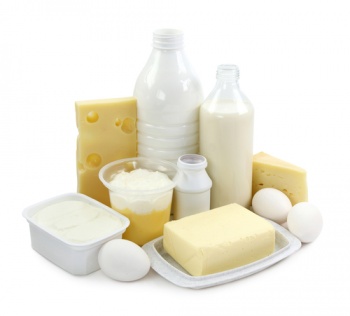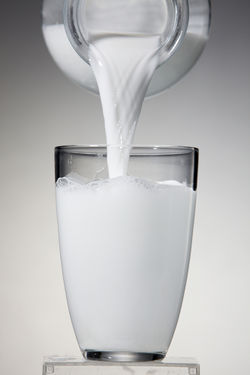Dairy
| See Also | Clinical Nutrition |
|---|
Dairy is a broad category of food products derived from the milk of cows. The term is sometimes used to refer to products from the milk of any mammal, yet when looking at the health impact of dairy it is helpful to separate milk products made from cows from those made from goat or sheep as they have different proteins and are often tolerated differently in the body. The main food sources of dairy include milk, yoghurt, soft cheeses, hard cheese, butter, whey protein, cream, condensed milk and powered milk products.
Dairy is a nutrient-dense food that can be very beneficial to health. On the other hand it is one of the foods that people are commonly sensitive to and can contribute to a number of health concerns. The inclusion of dairy in the diet needs to be based on how each individual reacts to the consumption of dairy.
Contents
Nutritional Value
| See Also | Milk Alternatives |
|---|
The nutrients in dairy include:
- It is a rich source of calcium".[1]
- It contains all the essential amino acids and is considered a complete protein.[2]
- Milk is the only significant animal source of carbohydrate.[3]
- Dairy contains the proteins casein, lactalbumin, and whey.
- Organic plain yogurt often contains live bacterial cultures which promote a healthy balance of intestinal flora which in turn is protective against many pathogens and diseases.[2]
- Yogurt stimulates the production of interferon by the immune system. Interferon is a cytokine that activates natural killer cells, a component of the immune system which destroy viruses and tumor cells.[2]
- Butter contains saturated fat and cholesterol.
- Butter can be mixed with equal parts olive oil as a way of diluting these substances.[4] Olive oil has cardioprotective effects, and can thus help to offset the effect of saturated fat on the cardiovascular system.
- Clarified butter contains butyric acid which has antiviral and anti-cancer properties. Clarified butter has also been shown to raise the level of interferon in the body when ingested.[4]
Associated Symptoms and Conditions
Dairy is protective against some conditions and the cause of others.
Health Benefits
As the consumption of dairy products decreases, the incidence of disorders that occur as a result of calcium deficiency such as osteoporosis, heart disease, and colon cancer, tend to rise.[1]
Dairy has been found to be protective against the following conditions:
- The consumption of dairy products appears to be more effective in decreasing blood pressure, than taking calcium supplements.[1]
Health Concerns
Dairy has been found to cause or aggravate the following conditions:
- Mucous Forming
- Gastrointestinal Reactions
- Dairy sensitivities
- Dairy sensitivities occur when the immune system reacts to the proteins in dairy products, such as casein, lactalbumin, and whey.[1] Dairy sensitivities include: food allergies, food intolerances and lactose intolerance.
- Dairy allergies are very rare. They result in an immediate allergic reactions (anaphylaxis) that occur directly after consumption of the dairy product, and can be fatal.[1]
- Dairy intolerance results in a delayed allergic reactions that develops more gradually and cause long-term, low-grade inflammation within the body. These type of reactions are more common and typically present with irritation of the skin, gastrointestinal tract or respiratory tract.[1] If dairy intolerances persist untreated (which means the removal of dairy), they can result in nephrosis, eczema, rheumatoid arthritis, appendicitis and can predispose affected individuals to infections such as those caused by group A beta-hemolytic streptococcus.[6]
- Dairy sensitivities, as well as other food reactions, can cause a wide variety of psychiatric conditions including mood and behavioral disorders.[6]
- In some individuals, dairy allergies can cause an aggravation of existing health conditions such as asthma, sinusitis, bronchitis, environmental allergies, or autoimmune disorders.[2]
- Lactose intolerance is a condition in which there is insufficient quantities of the enzyme lactase present for the proper digestion of dairy products.[7]
- Lactase is the enzyme that digests the sugar lactose which is a combination of glucose and galactose and is the form of sugar found in milk. Though typically plentiful in infants, the quantity of this enzyme that is produced by the body declines naturally with age.[7]
- When a person with lactose intolerance consumes dairy products that contain lactose, they can develop symptoms ranging from mild dyspepsia, burping, bloating and flatulence, to severe abdominal cramping and diarrhea.[1] Lactose intolerance can lead to severe gastrointestinal disorders if the individual with this affliction continues to consume food containing lactose.[6]
- Galactosemia
- Galactosemia is a rare condition in which the affected individual does not produce the enzyme galactose-1-phosphate transferase, which is an enzyme necessary for the metabolism of the monosaccharide galactose.[7] If a person lacking this enzyme consumes food containing galactose or lactose, such as dairy products, toxins build up in the body as a result of the incomplete metabolism of galactose-1-phosphate. This causes initial symptoms such as vomiting and weight loss, and if ingestion continues, can cause cirrhosis of the liver, mental retardation, cataracts, and eventual death.[7] This disorder is typically diagnosed in infancy as a result of routine screening.[1]
- Acidifying Effect
- Milk has an acidifying effect on the body if it has been sterilized, ultra pasteurized, or homogenized. Whole milk, that has not undergone these processes is alkalizing. The acidifying effect of cheese increases with their age, and fat content.[8]
Considerations
- Dairy products can be high in residues from pesticides and herbicides. This is because residues from these substances can remain on the crops that they are applied to and then be ingested by the cows/sheep/goats that eat these crops as feed. Pesticide and herbicide residues accumulate over months and years in the fatty tissue of the animals and are expressed in their milk.[4], [9]
- When dairy products are consumed by humans, such chemicals are retained and further concentrated in human fatty tissue. This process is called bio-accumulation. It occurs because fat soluble chemicals, when ingested, are typically not effectively excreted. Through this process, humans can come to contain much higher levels of chemical residues than the cows who ate the chemically treated crops. There is a growing body of evidence to suggest that the bioaccumulation of pesticide and herbicide residues in humans causes detrimental health effects such as carcinogenicity, genotoxicity and hormone disruption.[9] For this reason, it is preferable to consume dairy products that come from animals that did not consume feed treated with pesticides and herbicides
- Hormones
- If milk producing animals were administered drugs and or hormones prior to the time that the milk was obtained from them, residues of these substances can also be transferred to the dairy products.[10]
- It is best to choose organic milk without hormones.
- Breastmilk
- Dairy products and formula are not adequate substitutes for breast milk.[4] Breast milk should be prioritized above all other foods for nursing infants. This is because infants who are breast fed have lower incidences of a wide variety of infections and diseases including ear infections, gastroenteritis, candidiasis, urinary tract infections, sudden infant death syndrome, and asthma.[11]
- Breast fed children have also been shown to have faster cognitive development than children who are fed formula.[11]
- Introduction of Dairy to Infants
- Infants that consume cows milk before three months of age have an increased chance of developing an allergy to milk as they age.[6]
- Feeding infants cows milk increases the likelihood that they will becoming iron deficient.[6] The gastrointestinal irritation that cows milk can cause, leads to a decreased absorption of iron in the intestines.
- Other Considerations
- Soured and fermented dairy products are typically easier for people over seven years of age to digest than non soured/fermented dairy products.[4]
- Consuming clarified butter helps to heal inflammatory conditions of the gastrointestinal tract such as ulcers and colitis.[4]
- Goats milk tends to be higher in minerals and other nutrients than cows milk. This is because, when permitted to, goats graze on a wide variety of flora including bushes, bark, and herbs.[4]
Non-Dairy Sources of Calcium
The following are non-dairy sources of calcium
References
Co-Authored by:
- Dr. Iva Lloyd, BScH, RPE [2]
- Dr. Raymond Trott, ND
- ↑ 1.0 1.1 1.2 1.3 1.4 1.5 1.6 1.7 Pizzorno JE, Murray MT (2006) A Textbook of Natural Medicine, 2nd Edition, Churchill Livingston Elsevier.
- ↑ 2.0 2.1 2.2 2.3 Dunne Lavon J (2002) Nutrition Almanac, Fifth Edition McGraw-Hill.
- ↑ Berdanier Carolyn D, Zempleni Janos (2009) Advanced Nutrition, Macronutrients, Micronutrients, and Metabolism CRS Press.
- ↑ 4.0 4.1 4.2 4.3 4.4 4.5 4.6 Pitchford Paul (2002) Healing With Whole Foods: Asian traditions and modern nutrition North Atlantic Books.
- ↑ Clinic experience
- ↑ 6.0 6.1 6.2 6.3 6.4 6.5 Hoffer Abram, Prousky Jonathan (2006) Naturopathic Nutrition, a Guide to Health Food and Nutritional Supplements CCNM press.
- ↑ 7.0 7.1 7.2 7.3 Spallholz Julian E (1999) Nutrition, Chemistry and Biology, Second Edition, CRC Press.
- ↑ Vasey Christopher. (1999). The Acid-Alkaline Diet for Optimum Health: Restore your Health by Creating pH Balance in Your Diet Healing Arts press
- ↑ 9.0 9.1 LeDoux Martial (2011) Analytical methods applied to the determination of pesticide residues in foods of animal origin. A review of the past two decades. Journal of Chromatography;1218(8):pp:1021-1036.
- ↑ Dunne Lavon J (2002) Nutrition Almanac, Fifth Edition, McGraw-Hill.
- ↑ 11.0 11.1 Wall Ginna (2010) Internet. Outcomes of breast feeding verses formula feeding La Leche League International. [cited 2012 June]. Available from: [1]

